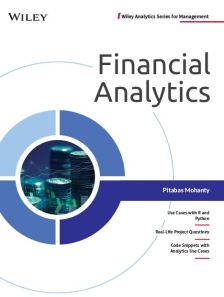Financial Analytics
ISBN: 9789354644177
684 pages
For more information write to us at: acadmktg@wiley.com

Description
Financial Analytics applies modern data science tools to explore and understand interesting financial data patterns. Though the use of quantitative tools is nothing new in finance, modern financial analytics is different due to three recent trends: i) improved computing power with the availability of GPUs and TPUs, ii) advanced ML and AI algorithms, and iii) access to large volumes of practically all types of data. The new-age Financial Analytics takes a data-driven approach to study finance. Instead of making assumptions about the distribution of data or the relationship between variables, it simply lets the data speak for itself.
1. Introduction to Finance Analytics
1.1 Analytics in Finance
1.2 Data-Driven Finance
1.3 Organization of the Book
1.4 Use of R and Python
1.5 What this Book is Not About
1.6 Data and Codes Used in this Book
1.7 Skills and Resources Needed to Excel in Finance Analytics
2. Data in Finance
2.1 Introduction
2.2 Fundamental Data
2.3 Obtaining Fundamental Data
2.4 Marker Data
2.5 Analysts’ Data
2.6 Alternate Data
2.7 Downloading Data Using an API
3. Wrangling Financial Data
3.1 Reading Financial Data
3.2 Check Data Types (Variable Types)
3.3 Clean Variable Names
3.4 Managing Missing Data
3.5 Managing Invalid Data
3.6 Managing Outliers
3.7 Long and Wide Form Data
4. Exploratory Analysis of Financial Data
4.1 Introduction
4.2 Univariate Analysis of Fundamental Data
4.3 Bi-variate and Multi-variate Analysis of Fundamental Data
4.4 Analysis of Time Series Data
5. Understanding Basic Finance using R and Python
5.1 Introduction
5.2 Time Value of Money
5.3 Risk and Return
5.4 Asset Valuation
6. Accounting Data Analytics
6.1 Introduction
6.2 Case 1: Detecting Patterns in Financial Statements
6.3 Case 2: Predicting Corporate Bankruptcy
7. Applications of Natural Language Processing in Finance
7.1 Sourcing Text Data
7.2 Text Preprocessing
7.3 Case 1: Summarizing a Document
7.4 Case 2: Sentiment Analysis
7.5 Case 3: Sentiment Analysis Using Machine Learning
8. Financial Fraud Analytics
8.1 Benford’s Law
8.2 Predicting Credit Card Frauds
9. Valuation Analytics
9.1 Introduction
9.2 Theory of Valuation
9.3 Building a Valuation Model
9.4 Creating a Valuation Function
9.5 Estimating Implied Returns
9.6 Extension of the Model
9.7 Building the Valuation Function in Python
9.8 Valuation of Walmart Inc.
10. Portfolio Analytics
10.1 Introduction
10.2 Return and Risk of a Portfolio
10.3 Markowitz Optimization Process
10.4 Portfolio Optimization using Python
10.5 Portfolio Performance Evaluation
10.6 Portfolio Insurance
11. Developing and Backtesting Technical Trading Rules
11.1 Trend Indicators
11.2 Momentum Indicators
11.3 Volatility Indicators
11.4 Volume Indicators
11.5 Backtesting
11.6 Technical Analysis in Python
11.7 Comparing 5-day EMA with 21-day EMA in Python
11.8 Quantstrat to Automate Backtesting
12. Predicting Stock Prices/Returns
12.1 Predicting Stock Returns Based on Accounting Ratios
12.2 Predicting Stock Returns (Prices) using Past Stock Returns (Prices) Data
12.3 Predicting Stock Prices using Technical Indicators
12.4 Predicting Stock Returns using Valuation Multipliers and Value Drivers
12.5 Predicting Returns Based on Factor Exposures/Stock Characteristics
Appendix 1: Installing R and Python
Appendix 2: Introduction to R
Appendix 3: Introduction to Python
Appendix 4: A Concise Introduction to Machine Learning
Index

